Summer’s here, and there’s no better way to cool off and get an amazing workout than by getting into tow sports. Whether you are wakeboarding, water skiing, or wakesurfing, there’s an exhilarating tow sport for everyone in the family. Let’s explore the many ways you can have fun behind your boat.
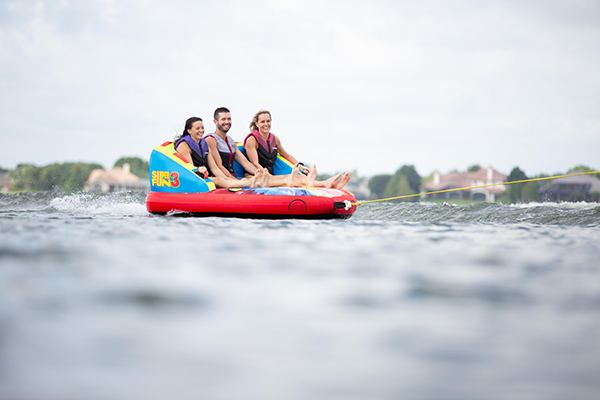
Tube Riding
For an adrenaline-pumping ride, try tubing. Towable tubes come in various sizes and styles, from single to multi-passenger designs. Some tubes are designed for sitting for a leisurely ride, while others are for lying on, offering a more exciting experience.Tube lines are 60 feet long to keep riders from being whipped too far out when the boat turns. Tube lines also come in various thicknesses to match the size of the tube. Riding a tube is an excellent introduction to the sensation of being towed by a boat, making the transition to wakeboarding or water skiing easier.
Safety Tip: The driver should always stay away from boating traffic, swimmers, and obstructions, especially when towing a tube rider, as the rider cannot steer the tube.
Boat speed: 15 to 20 mph.
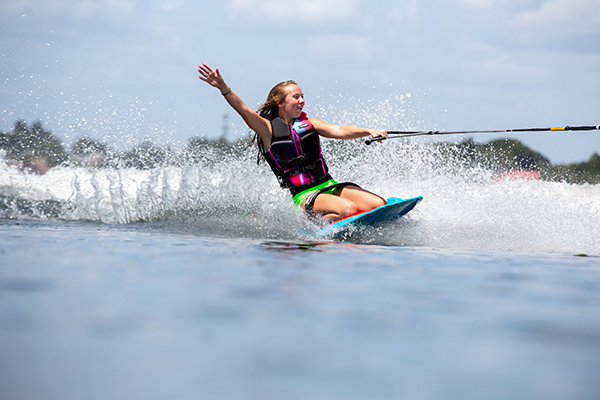
Kneeboarding
With their large surface area, kneeboards make it easy for kids to get up on the water without standing. Once up, you can start carving back and forth, crossing the boat’s wake, and performing 180-degree rotations. Some boards have small molded-in fins to help traction but still allow for rotations, while others have retractable fins or none for easier spins. As you gain confidence, you can advance to 360-degree spins and even aerial spins while jumping the wake.
Coaching Tip: Start by lying on the kneeboard until it planes, and then bring the knees up to kneel on the contoured pad. Placing the belt snugly over the thighs provides better stability.
Boat speed: 10 to 20 mph.
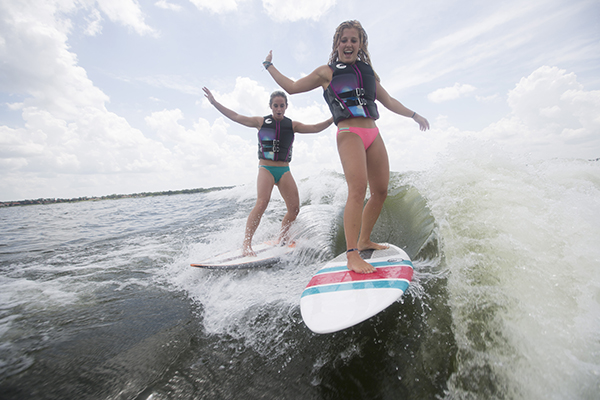
Wakeboarding
A favorite for teens and young adults, wakeboarding features a sideways stance similar to snowboarding, allowing for riding either right foot or left foot forward. Beginners start with surface spins and wake jumps, while advanced riders can perform spins and inverts like back rolls and tantrums (backflips off the wake).Successfully jumping and clearing the boat’s wake indicates you are using the proper technique. Jumping the wake from either direction and riding both right foot and left foot forward allows for a variety of tricks.
Coaching Tip: Balance your weight over your bindings to jump the boat’s wakes effectively. Stand directly over both bindings evenly for optimal balance.
Bend your ankles and knees to distribute your weight better and for optimal
board control.
Boat Speed: 15 to 22 mph.
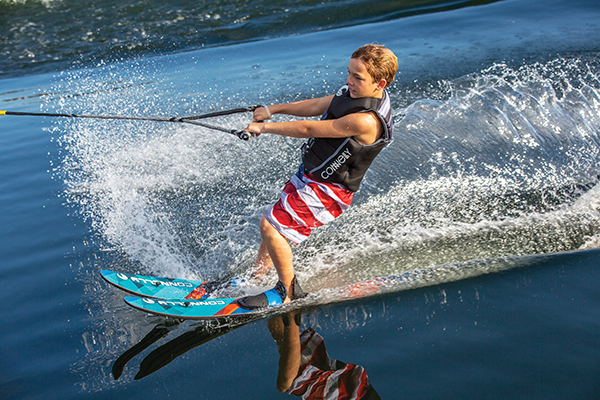
Water Skiing
Water skiing on two skis is the classic tow sport, first invented by Ralph Samuelson on Lake Pepin, Minnesota in 1922. Modern skis come in sizes for all ages with smaller skis for youngsters and teenagers and longer, wide-body skis offering easier starts for adults. Slalom skis for teens and adults range from 63” to 71” in length.
Once you develop a solid position on two skis with ankles and knees bent and back, upright, you can start edging back and forth across the boat’s wake. As you gain confidence, move up to slaloming on a single ski for more aggressive edging through the boat’s wake and sharper turns that throw a big spray.
Coaching Tip: Whether on two skis or a single ski, balance your weight over the middle of the feet. Ensure your hips are up and over the middle of your feet with some bend in your knees and ankles. Avoid squatting, which makes your hips fall back, putting too much weight on the tail of the skis or ski.
Two skis boat speed: 15 mph for small kids to 28 mph for adults.
Slalom ski boat speed: 22 to 32 mph.
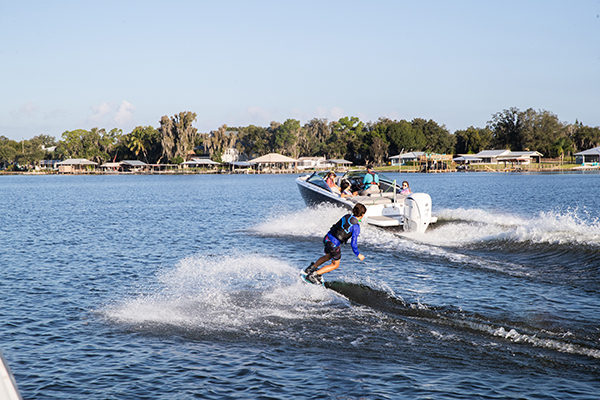
Wakeskating
Wakeskating features a small board typically 39” to 46” in length and, like a skateboard, does not have bindings. The top of the board features a grip type-surface, and riders wear special shoes for added stability, adopting a sideways stance similar to skateboarding. This setup allows for a variety of skateboarding-inspired tricks such as ollies (using the back foot to pop the board in the air) and shuvits (rotating the board 180 degrees in the air).
Coaching Tip: Once up, use your feet and lower body strength to rotate the board 180 degrees. Become comfortable riding the wakeskate in either direction and begin working on popping the boat’s wake with either foot forward, opening the door to many tricks.
Boat speed: 15 to 20 mph.
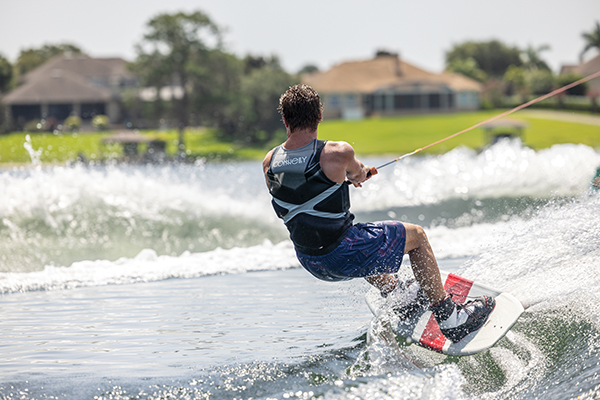.jpg)
Wakesurfing
Surfing behind a boat, first done in the early 60s, has exploded in popularity over the past 20 years. Modern wakesurfing uses smaller boards designed for carving and tricks. Like wakeskating, wakesurfing doesn’t use bindings and features a sideways stance.
Wakesurf boards come in three styles: surf, skim, and hybrid. Surf style generally ranges from 4’4” to 5’6” in length, resembling a traditional surfboard, providing plenty of surface area for beginners and designed for carving. Smaller wakesurfers are available for kids. Skim boards are smaller with smaller fins, making them suitable for skateboard-inspired tricks like spins on the water and in the air. Hybrid models combine elements of both surf and skim.
Once the tow line is released, wakesurfers enjoy an exhilarating sense of freedom, controlling speed and direction by shifting body weight over the feet. More weight
on the front foot increases the board’s speed, while weight on the back foot slows it down.
Safety Tip: Wakesurfing should not be done behind an outboard-powered boat because of the proximity of the propeller to the surfer. However, Yamaha jet-
powered boats are perfect for wakesurfing as they do not have a propeller.
Boat speed: 10 to 12 mph.
Whatever tow sport you choose, you’re guaranteed to have a blast this summer. Get out on the water, try something new, and create unforgettable memories behind the boat.
Safety Tip: When doing tow sports, drivers should use a tow sports mirror and a designated spotter to increase visibility and awareness. The person in tow should always wear a Coast Guard-approved flotation vest that fits snugly.
Back to Blue Life

Tube Riding
For an adrenaline-pumping ride, try tubing. Towable tubes come in various sizes and styles, from single to multi-passenger designs. Some tubes are designed for sitting for a leisurely ride, while others are for lying on, offering a more exciting experience.Tube lines are 60 feet long to keep riders from being whipped too far out when the boat turns. Tube lines also come in various thicknesses to match the size of the tube. Riding a tube is an excellent introduction to the sensation of being towed by a boat, making the transition to wakeboarding or water skiing easier.
Safety Tip: The driver should always stay away from boating traffic, swimmers, and obstructions, especially when towing a tube rider, as the rider cannot steer the tube.
Boat speed: 15 to 20 mph.

Kneeboarding
With their large surface area, kneeboards make it easy for kids to get up on the water without standing. Once up, you can start carving back and forth, crossing the boat’s wake, and performing 180-degree rotations. Some boards have small molded-in fins to help traction but still allow for rotations, while others have retractable fins or none for easier spins. As you gain confidence, you can advance to 360-degree spins and even aerial spins while jumping the wake.
Coaching Tip: Start by lying on the kneeboard until it planes, and then bring the knees up to kneel on the contoured pad. Placing the belt snugly over the thighs provides better stability.
Boat speed: 10 to 20 mph.

Wakeboarding
A favorite for teens and young adults, wakeboarding features a sideways stance similar to snowboarding, allowing for riding either right foot or left foot forward. Beginners start with surface spins and wake jumps, while advanced riders can perform spins and inverts like back rolls and tantrums (backflips off the wake).Successfully jumping and clearing the boat’s wake indicates you are using the proper technique. Jumping the wake from either direction and riding both right foot and left foot forward allows for a variety of tricks.
Coaching Tip: Balance your weight over your bindings to jump the boat’s wakes effectively. Stand directly over both bindings evenly for optimal balance.
Bend your ankles and knees to distribute your weight better and for optimal
board control.
Boat Speed: 15 to 22 mph.

Water Skiing
Water skiing on two skis is the classic tow sport, first invented by Ralph Samuelson on Lake Pepin, Minnesota in 1922. Modern skis come in sizes for all ages with smaller skis for youngsters and teenagers and longer, wide-body skis offering easier starts for adults. Slalom skis for teens and adults range from 63” to 71” in length.
Once you develop a solid position on two skis with ankles and knees bent and back, upright, you can start edging back and forth across the boat’s wake. As you gain confidence, move up to slaloming on a single ski for more aggressive edging through the boat’s wake and sharper turns that throw a big spray.
Coaching Tip: Whether on two skis or a single ski, balance your weight over the middle of the feet. Ensure your hips are up and over the middle of your feet with some bend in your knees and ankles. Avoid squatting, which makes your hips fall back, putting too much weight on the tail of the skis or ski.
Two skis boat speed: 15 mph for small kids to 28 mph for adults.
Slalom ski boat speed: 22 to 32 mph.

Wakeskating
Wakeskating features a small board typically 39” to 46” in length and, like a skateboard, does not have bindings. The top of the board features a grip type-surface, and riders wear special shoes for added stability, adopting a sideways stance similar to skateboarding. This setup allows for a variety of skateboarding-inspired tricks such as ollies (using the back foot to pop the board in the air) and shuvits (rotating the board 180 degrees in the air).
Coaching Tip: Once up, use your feet and lower body strength to rotate the board 180 degrees. Become comfortable riding the wakeskate in either direction and begin working on popping the boat’s wake with either foot forward, opening the door to many tricks.
Boat speed: 15 to 20 mph.
.jpg)
Wakesurfing
Surfing behind a boat, first done in the early 60s, has exploded in popularity over the past 20 years. Modern wakesurfing uses smaller boards designed for carving and tricks. Like wakeskating, wakesurfing doesn’t use bindings and features a sideways stance.
Wakesurf boards come in three styles: surf, skim, and hybrid. Surf style generally ranges from 4’4” to 5’6” in length, resembling a traditional surfboard, providing plenty of surface area for beginners and designed for carving. Smaller wakesurfers are available for kids. Skim boards are smaller with smaller fins, making them suitable for skateboard-inspired tricks like spins on the water and in the air. Hybrid models combine elements of both surf and skim.
Once the tow line is released, wakesurfers enjoy an exhilarating sense of freedom, controlling speed and direction by shifting body weight over the feet. More weight
on the front foot increases the board’s speed, while weight on the back foot slows it down.
Safety Tip: Wakesurfing should not be done behind an outboard-powered boat because of the proximity of the propeller to the surfer. However, Yamaha jet-
powered boats are perfect for wakesurfing as they do not have a propeller.
Boat speed: 10 to 12 mph.
Whatever tow sport you choose, you’re guaranteed to have a blast this summer. Get out on the water, try something new, and create unforgettable memories behind the boat.
Safety Tip: When doing tow sports, drivers should use a tow sports mirror and a designated spotter to increase visibility and awareness. The person in tow should always wear a Coast Guard-approved flotation vest that fits snugly.
Back to Blue Life
